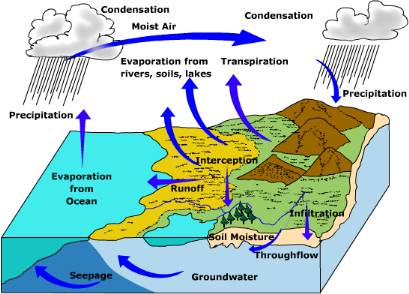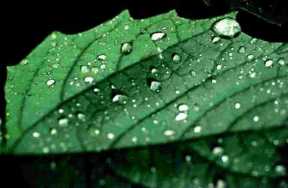The Hydrologic Cycle
The hydrologic cycle, or water cycle, is the cycling of water through the earth system. Not only is the hydrologic cycle a cycle of water, it is a cycle of energy as well. Over the next several pages we'll trace water as it passes through the earth system and the energy that accompanies it.

Figure 10.3 The Hydrologic cycle
Evaporation and Condensation
Evaporation is the phase change of liquid water into a vapor (gas). Evaporation is an important means of transferring energy between the surface and the air above. The energy used to evaporate water is called "latent energy". Latent energy is "locked up" in the water molecule when water undergoes the phase change from a liquid to a gas. Eighty-eight percent of all water entering the atmosphere originates from the ocean between 60o north and 60o south latitude. Most of the water evaporated from the ocean returns directly back to the ocean. Some water is transported over land before it is precipitated out. When water vapor condenses back into a liquid it releases latent heat, which is converted into sensible heat warming the surrounding air. The warming of the surrounding air fuels uplift to help promote adiabatic cooling and further condensation. As droplets of water coalesce into larger droplets they attain a size big enough to fall towards the earth as precipitation. Located high in the troposphere, rain drops possess a high degree of potential energy that is converted into kinetic energy once they begin to fall toward the surface. Impacting the surface they convert this kinetic energy into work done on the surface (erosion for example).
Interception and Infiltration
As water reaches the surface in various forms of precipitation, it is intercepted by plants or falls directly to the surface. Precipitation that collects on the leaves or stems of plants is known as interception. The amount of water intercepted by a plant largely depends on plant form. Water is held on the leaf surface until it either drips off as through fall or trickles down the leaf stem finally reaching the ground as stem flow. Interception of falling rain buffers the surface against erosion. Coniferous trees tend to intercept more water than deciduous trees on an annual basis because deciduous trees drop their leaves for a period of time.
Figure 10.4 Droplets of water intercepted by tree leaf. 
(Source: M. Marzot FAO. Used with permission)
Upon reaching the ground, some water infiltrates into the soil, possibly percolating down to the groundwater zone or it may run across the surface as runoff. Infiltration refers to water that penetrates into the surface of soil. Infiltration is controlled by soil texture, soil structure, vegetation and soil moisture status. High infiltration rates occur in dry soils, with infiltration slowing as the soil becomes wet. Coarse textured soils with large well-connected pore spaces tend to have higher infiltration rates than fine textured soils. However, coarse textured soils fill more quickly than fine textured soils due to a smaller amount of total pore space in a unit volume of soil. Runoff is generated quicker than one might have with a finer textured soil.
Vegetation also affects infiltration. For instance, infiltration is higher for soils under forest vegetation than bare soils. Tree roots loosen and provide conduits through which water can enter the soil. Foliage and surface litter reduce the impact of falling rain keeping soil passages from becoming sealed.
For Citation: Ritter, Michael E.
The Physical Environment: an Introduction to Physical Geography.
2006. Date visited. https://www.earthonlinemedia.com/ebooks/tpe_3e/title_page.html
©2003-2016
Michael
Ritter (tpeauthor@mac.com)
Help keep this site available by donating through PayPal.